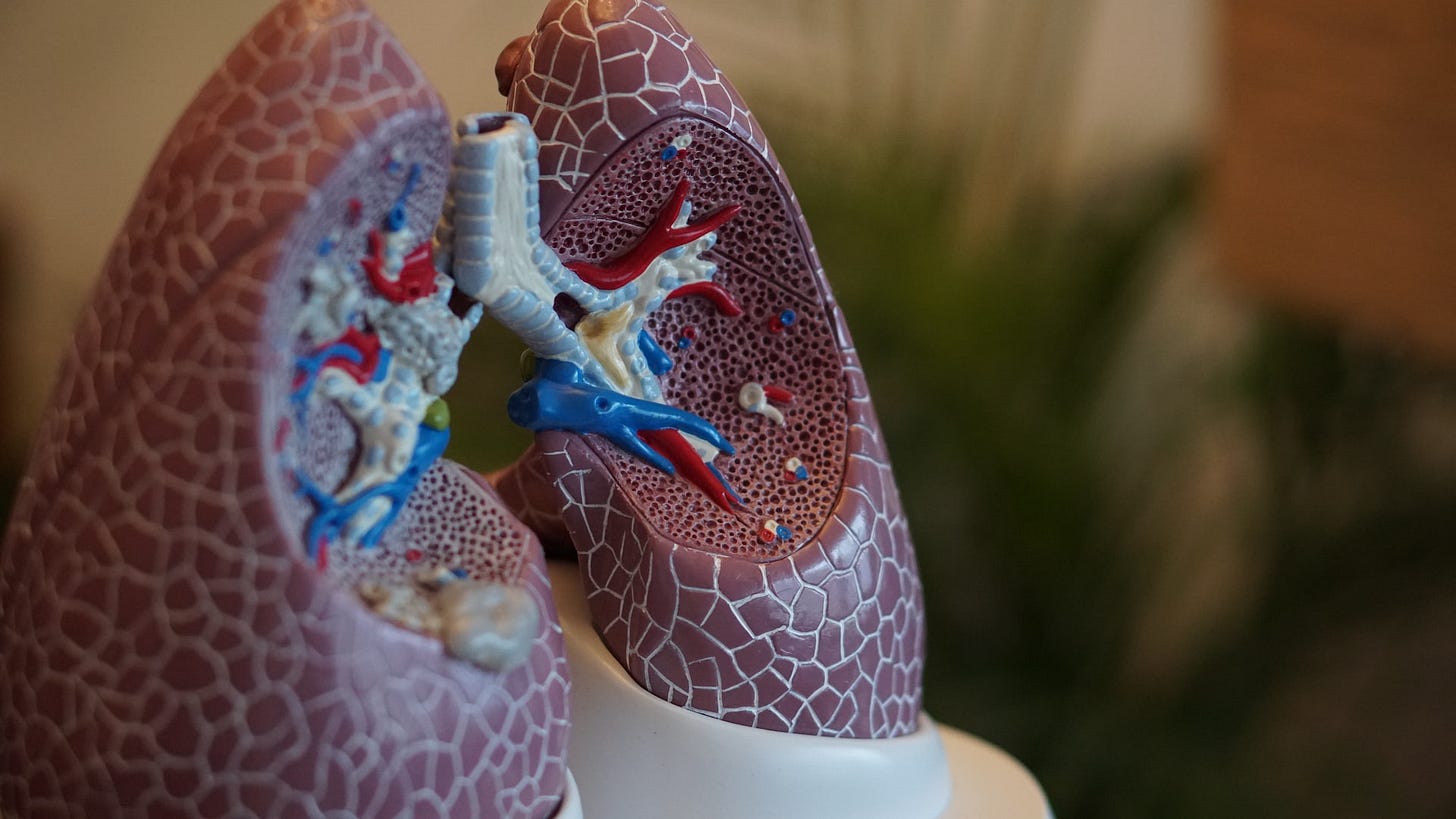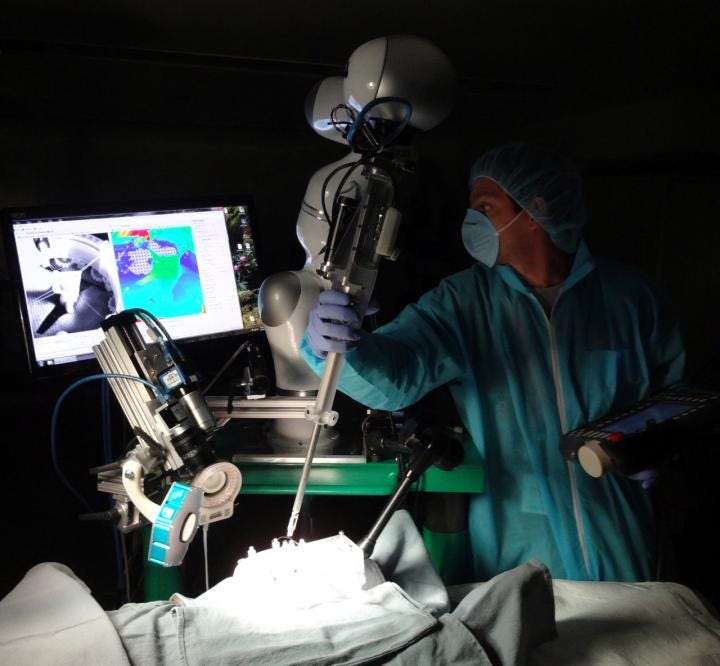AI Won’t Replace Your Doctor—But It Might Help Save Your Life
How the next medical revolution mirrors the computer age—and why humans still matter most
When computers started replacing typewriters in the workplace, people panicked. Would their jobs disappear? Would machines take over?
We’ve heard it all before, and now we’re hearing it again, this time with artificial intelligence.
But here’s what history teaches us: the real transformation doesn’t come from the technology alone. It comes from how humans use it.
Today, AI isn’t replacing doctors—it’s helping them do what they already do best, but faster, smarter, and more precisely. From diagnosing cancer earlier than ever before to performing surgeries with millimeter-perfect accuracy, AI is reshaping medicine through partnership, not replacement.
In this article, we look at how AI is quietly saving lives—not by taking over, but by teaming up with the people who care for us.
Historical Precedent: Lessons from the Typewriter-to-Computer Transition
The Office Automation Revolution
During the 1970s–1990s, typewriters gave way to computers - machines that would soon become indispensable across nearly every industry. At first, there was fear. Would administrative jobs vanish? Would people become obsolete?
Instead, the opposite happened. Secretaries became IT specialists. Typists turned into data analysts. New roles emerged that paid more, used deeper skill sets, and offered upward mobility.
The lesson? Technology doesn’t eliminate people. It eliminates repetitive tasks, freeing humans to take on higher-value work.
Parallels with Modern AI Adoption
Like computers, AI systems excel at repetitive, rules-based tasks but lack contextual reasoning and ethical judgment. A 2024 study found that while AI-generated surgical reports had 87.3% accuracy compared to surgeons’ 72.8%, these systems still required human validation to avoid critical errors in 12.7% of cases 3,6.
This mirrors early computer adoption, where workers initially distrusted automated calculations but later leveraged them to focus on strategic analysis. The pattern repeats: technology handles mechanistic work, freeing humans for higher-order problem-solving 8,12.
AI in Medicine: Enhancing Diagnostics and Surgical Outcomes
Early Disease Detection Breakthroughs
AI’s ability to analyze vast datasets has revolutionized diagnostics. Mayo Clinic’s AI model detects pancreatic cancer in CT scans 475 days earlier than traditional methods, achieving 92% accuracy 1,9,13,15. Similarly, deep learning algorithms screening lung CT scans reduce false negatives by 11% compared to radiologists, potentially saving 160,000 lives annually in the U.S. alone 2,4.
These tools don’t replace doctors but augment their capabilities, flagging subtle patterns invisible to the human eye while relying on clinicians to interpret results within broader patient contexts 5, 14.
Case Study: Sybil’s Lung Cancer Predictions
Developed at Mass General Hospital, the AI model Sybil predicts lung cancer risk by analyzing low-dose CT scans. In trials, Sybil identified high-risk patients 94% of the time, enabling earlier interventions that boost five-year survival rates from 5% (late-stage) to 55% (early-stage)2.
Crucially, Sybil doesn’t diagnose; it prioritizes cases for human review, streamlining workflows without bypassing physician expertise 2,8.
Autonomous Surgery: Precision Meets Human Oversight
Robotic systems like Johns Hopkins’ STAR (Smart Tissue Autonomous Robot) exemplify AI’s surgical potential. In 2022, STAR performed intestinal anastomoses, a delicate procedure requiring millimeter-perfect sutures, with fewer errors than human surgeons 3.
However, its success hinges on pre-programmed guidelines developed by surgical teams and real-time human monitoring to handle unforeseen complications. As one researcher noted, “The robot excels at repetitive precision, but surgeons remain irreplaceable for adaptive decision-making” 3,12.
The Human-AI Collaboration Framework
Augmented Intelligence in Practice
The concept of augmented intelligence-AI enhancing human skills rather than replacing them-is gaining traction. In pathology, AI reduces diagnostic errors in lymph node cancer detection from 3.4% to 0.5%, but only when used as a “second opinion” tool for pathologists 4,6.
Similarly, AI-powered apps like Ubie guide patients through symptom checks, yet 29.1% of cases still require escalation to human doctors for final diagnosis 7,14. These systems thrive under human stewardship, ensuring ethical and contextual fidelity 8,16.
Training the Next Generation of Operators
As with the computer revolution, AI adoption demands workforce reskilling. Surgeons now train alongside systems like the da Vinci robot, learning to interpret AI-generated intraoperative analytics 3,12.
Radiologists study AI-driven heatmaps that highlight suspicious lesions, refining their diagnostic acumen 5,13. This upskilling mirrors how typists transitioned to data analysts-by mastering tools that amplify their innate capabilities 1,9.
Societal Impact: Saving Lives Through Faster, Smarter Care
Stroke Care: Minutes Matter, AI Delivers
In stroke treatment, every minute saved preserves 1.9 million neurons. AI tools like RapidAI® and Viz.ai analyze CT scans in seconds, slashing diagnosis times by 40% and enabling thrombectomies within critical windows 5,12,14,16.
At UC Davis Health, AI integration reduced 30-day mortality rates from 27.7% to 17.5% and improved post-stroke mobility scores by 12% 6,14. These systems don’t replace neurologists-they empower them to act decisively with AI-curated insights 5,16.
Fracture Detection: Reducing Diagnostic Blind Spots
AI models now detect subtle fractures in X-rays with 85.2% accuracy, cutting missed diagnoses by 2–3 times 4. In Latvia, hospitals using AI for trauma imaging reported a 22% drop in delayed treatments, preventing complications like nonunion fractures and chronic pain 4. By acting as a “second pair of eyes,” AI ensures radiologists focus on complex cases while minimizing oversight 4,8.
Ethical Considerations and the Path Forward
Guardrails for Responsible Innovation
While AI’s potential is vast, its risks- algorithmic bias, data privacy breaches, over-reliance on automation- demand vigilant governance. The 2025 CB Insights report emphasizes “human-in-the-loop” frameworks where AI flags anomalies but humans make final decisions 8,16. For instance, autonomous surgical robots must include manual override protocols to address unexpected bleeding or anatomical variations 3,12.
Cultivating Public Trust Through Transparency
Historical resistance to computers eased as users understood their role as tools rather than replacements. Similarly, demystifying AI through public demonstrations like STAR’s surgeries and transparent diagnostic audits builds trust 3,13. Patients shown AI-generated cancer risk assessments alongside doctor explanations report higher confidence in treatment plans 9,15.
Conclusion: Writing the Next Chapter Together
The typewriter-to-computer transition didn’t erase human workers; it transformed them into architects of the digital age. Today’s AI revolution follows the same arc: machines excel at tasks, while humans excel at meaning.
From STAR’s sutures guided by surgeon blueprints to Sybil’s cancer predictions validated by radiologists, success emerges from collaboration, not competition 2,3,9.
As we integrate AI into medicine, business, and society, the imperative is clear: invest in tools that amplify human potential, prioritize ethical oversight, and foster adaptable mindsets.




